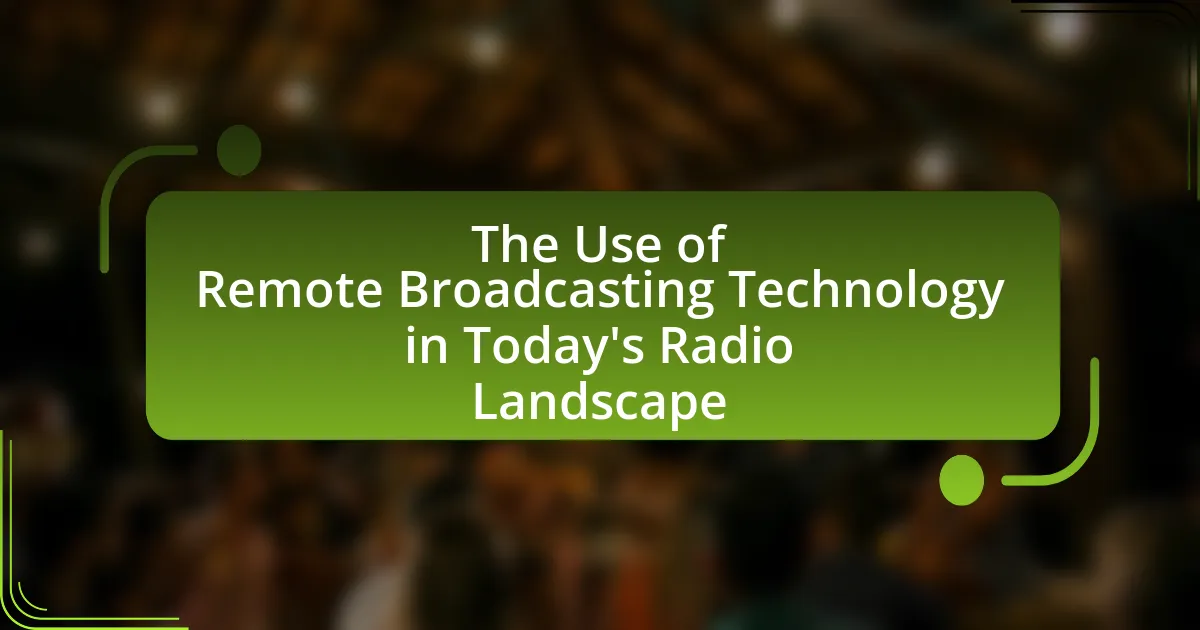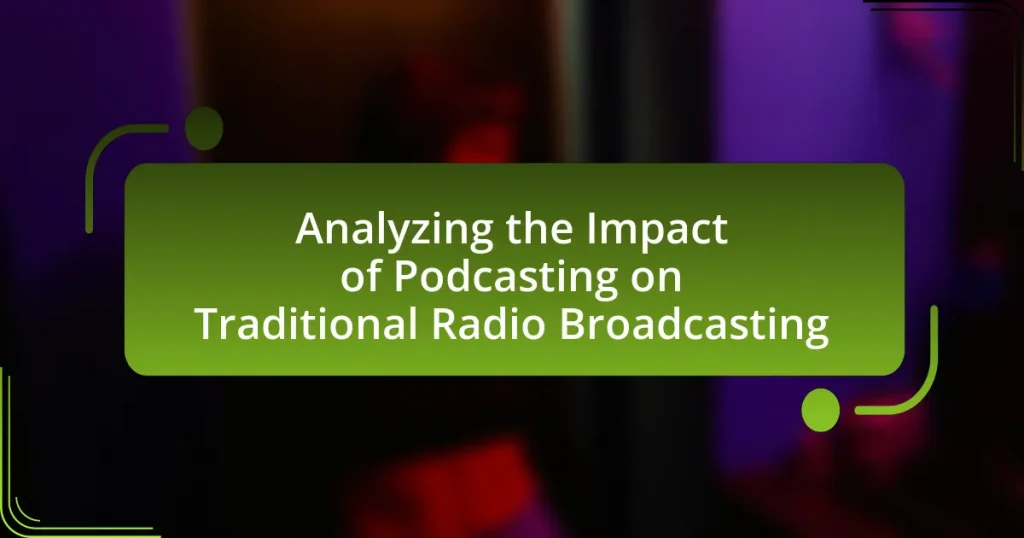Remote broadcasting technology is a pivotal component of today’s radio landscape, enabling stations to transmit audio content from various locations outside traditional studios. This article explores the evolution of remote broadcasting, highlighting advancements such as high-speed internet, mobile equipment, and cloud-based tools that enhance audio quality and audience engagement. It discusses the importance of remote broadcasting for reaching wider audiences, the challenges faced by traditional broadcasting, and the benefits it offers to different radio formats, including live events and news reporting. Additionally, the article examines future trends, potential risks, and best practices for ensuring effective and secure remote broadcasts.
What is Remote Broadcasting Technology in Today’s Radio Landscape?
Remote broadcasting technology in today’s radio landscape refers to the use of advanced digital tools and internet connectivity to transmit audio content from remote locations. This technology enables radio stations to broadcast live events, interviews, and shows from various venues outside of traditional studio settings, enhancing audience engagement and expanding reach. For instance, the adoption of mobile broadcasting units and software like IP-based streaming has increased significantly, allowing broadcasters to deliver high-quality audio with minimal latency. According to a report by the National Association of Broadcasters, over 70% of radio stations now utilize some form of remote broadcasting technology, reflecting its critical role in modern radio operations.
How has remote broadcasting technology evolved in recent years?
Remote broadcasting technology has significantly advanced in recent years, primarily through the integration of high-speed internet, cloud computing, and mobile applications. These advancements have enabled broadcasters to transmit high-quality audio and video content from virtually any location, enhancing flexibility and accessibility. For instance, the adoption of 5G networks has drastically reduced latency and improved streaming quality, allowing for real-time broadcasting without the need for traditional studio setups. Additionally, platforms like Zoom and OBS Studio have become essential tools for remote production, facilitating seamless collaboration among teams spread across different locations. This evolution reflects a broader trend towards decentralized broadcasting, where content creators can engage audiences directly and efficiently, adapting to the growing demand for on-the-go media consumption.
What technological advancements have influenced remote broadcasting?
Technological advancements that have influenced remote broadcasting include the development of high-speed internet, mobile broadcasting equipment, and cloud-based production tools. High-speed internet enables seamless transmission of audio and video content from remote locations, significantly improving the quality and reliability of broadcasts. Mobile broadcasting equipment, such as portable mixers and digital audio interfaces, allows broadcasters to capture high-quality sound in various environments. Additionally, cloud-based production tools facilitate collaboration and content management, enabling teams to work together efficiently regardless of their physical location. These advancements collectively enhance the capabilities and reach of remote broadcasting in today’s radio landscape.
How do these advancements improve radio broadcasting quality?
Advancements in remote broadcasting technology enhance radio broadcasting quality by enabling higher audio fidelity and reducing latency. Technologies such as digital audio processing and high-bandwidth internet connections allow for clearer sound transmission and real-time broadcasting without interruptions. For instance, the implementation of codecs like AAC and Opus improves compression efficiency, resulting in better sound quality at lower bit rates. Additionally, advancements in satellite and IP-based broadcasting facilitate seamless integration of remote locations, ensuring consistent audio quality regardless of geographical challenges. These improvements collectively lead to a more engaging and professional listening experience for audiences.
Why is remote broadcasting technology important for radio stations?
Remote broadcasting technology is important for radio stations because it enables them to reach wider audiences and enhance content delivery from various locations. This technology allows stations to broadcast live events, interviews, and news coverage directly from remote sites, increasing listener engagement and providing real-time updates. For instance, during significant events like concerts or sports games, remote broadcasting facilitates immediate coverage, which can attract more listeners and advertisers. Additionally, the use of mobile broadcasting units and internet-based streaming has become essential, as it allows stations to operate with greater flexibility and lower costs, ultimately improving their competitive edge in the evolving media landscape.
What challenges does traditional broadcasting face that remote technology addresses?
Traditional broadcasting faces challenges such as high operational costs, limited geographic reach, and inflexibility in content delivery, which remote technology effectively addresses. Remote technology reduces operational costs by enabling broadcasting from various locations without the need for extensive physical infrastructure, allowing for more flexible and cost-effective production. Additionally, remote technology expands geographic reach by facilitating live broadcasts from diverse locations, thus engaging wider audiences. Furthermore, it enhances content delivery flexibility, allowing broadcasters to adapt quickly to changing circumstances, such as emergencies or audience preferences, which traditional broadcasting struggles to accommodate.
How does remote broadcasting enhance audience reach and engagement?
Remote broadcasting enhances audience reach and engagement by allowing content creators to connect with listeners from diverse geographical locations without the limitations of traditional broadcasting infrastructure. This technology enables real-time interaction through live streaming, social media integration, and audience participation features, which significantly increases listener involvement. For instance, a study by the Pew Research Center found that 57% of Americans listen to online radio, indicating a shift towards digital platforms that remote broadcasting facilitates. Additionally, remote broadcasting allows for targeted content delivery, enabling broadcasters to tailor their programming to specific demographics, thereby improving engagement metrics.
What are the key features of remote broadcasting technology?
The key features of remote broadcasting technology include real-time audio and video transmission, flexibility in location, and advanced connectivity options. Real-time transmission allows broadcasters to deliver live content from various locations, enhancing audience engagement. Flexibility enables broadcasters to operate from remote sites, such as events or outdoor locations, without the need for traditional studio setups. Advanced connectivity options, such as IP-based streaming and satellite links, ensure reliable and high-quality broadcasts regardless of geographical constraints. These features collectively enhance the efficiency and reach of radio broadcasting in today’s digital landscape.
What types of equipment are essential for remote broadcasting?
Essential equipment for remote broadcasting includes microphones, audio interfaces, portable mixers, headphones, and reliable internet connectivity devices. Microphones capture audio, while audio interfaces convert analog signals to digital for transmission. Portable mixers allow for real-time audio adjustments, and headphones ensure sound quality monitoring. Reliable internet connectivity devices, such as mobile hotspots or satellite links, are crucial for maintaining a stable broadcast signal. These components collectively enable effective remote broadcasting, ensuring high-quality audio transmission and seamless communication.
How do software solutions facilitate remote broadcasting?
Software solutions facilitate remote broadcasting by enabling seamless audio and video transmission over the internet, allowing broadcasters to connect with audiences from any location. These solutions often include tools for live streaming, content management, and audience interaction, which enhance the broadcasting experience. For instance, platforms like OBS Studio and vMix provide user-friendly interfaces for live video mixing and streaming, while software like Zoom and Skype allows for remote interviews and discussions. According to a report by Statista, the global live streaming market is projected to reach $247 billion by 2027, highlighting the growing reliance on software solutions for effective remote broadcasting.
How is Remote Broadcasting Technology Used in Today’s Radio Landscape?
Remote broadcasting technology is extensively used in today’s radio landscape to facilitate live broadcasts from various locations outside of traditional studio settings. This technology enables radio stations to connect with audiences in real-time, enhancing listener engagement through on-site reporting, live events, and remote interviews. For instance, advancements in digital audio transmission and mobile broadcasting equipment allow broadcasters to transmit high-quality audio from remote locations, such as concerts or sports events, directly to their audience. According to a report by the National Association of Broadcasters, over 70% of radio stations have adopted some form of remote broadcasting technology, reflecting its critical role in modern radio operations.
What are the common applications of remote broadcasting technology?
Remote broadcasting technology is commonly applied in live event coverage, news reporting, and sports broadcasting. These applications enable broadcasters to transmit audio and video content from remote locations, ensuring real-time communication with audiences. For instance, during major events like concerts or sports games, remote broadcasting allows for seamless coverage, reaching viewers who cannot attend in person. Additionally, news organizations utilize this technology to report from disaster zones or breaking news situations, providing timely updates. The effectiveness of remote broadcasting is evidenced by its widespread adoption across various media outlets, enhancing audience engagement and information dissemination.
How do radio stations utilize remote broadcasting for live events?
Radio stations utilize remote broadcasting for live events by deploying mobile broadcasting units equipped with advanced audio and transmission technology. These units allow stations to capture and transmit live audio from various locations, such as concerts, sports events, or community gatherings, directly to their audience. For instance, the use of satellite or internet streaming technology enables real-time broadcasting, ensuring that listeners receive immediate coverage of the event. This method enhances audience engagement and expands the station’s reach, as evidenced by the increasing number of live remote broadcasts reported by industry surveys, which indicate that over 70% of radio stations incorporate remote broadcasting to connect with their listeners during significant events.
What role does remote broadcasting play in news reporting?
Remote broadcasting plays a crucial role in news reporting by enabling journalists to cover events in real-time from various locations, enhancing the immediacy and relevance of news stories. This technology allows for live updates and on-the-ground reporting, which is essential during breaking news situations, such as natural disasters or political events. For instance, during the COVID-19 pandemic, remote broadcasting facilitated timely updates from health officials and frontline workers, ensuring that audiences received accurate information as situations evolved. This capability not only improves audience engagement but also increases the credibility of news organizations by providing firsthand accounts and visuals directly from the scene.
How do different radio formats leverage remote broadcasting technology?
Different radio formats leverage remote broadcasting technology by utilizing mobile equipment and internet connectivity to reach audiences beyond traditional studio settings. For instance, news radio formats often employ remote broadcasting to cover live events, allowing real-time reporting and audience engagement. Similarly, music radio formats use remote technology to broadcast live concerts or DJ sets, enhancing listener experience with exclusive content. Sports radio formats capitalize on remote broadcasting to provide live commentary from various locations, ensuring comprehensive coverage of events. This adaptability is supported by advancements in digital transmission and portable broadcasting tools, which have made it feasible for diverse radio formats to maintain high-quality audio and reliable connections while broadcasting remotely.
What benefits do talk radio shows gain from remote broadcasting?
Talk radio shows gain several benefits from remote broadcasting, including increased audience reach, enhanced engagement, and cost-effectiveness. Remote broadcasting allows shows to connect with listeners in diverse geographical locations, expanding their listener base beyond local markets. This broader reach can lead to higher advertising revenue, as advertisers are often interested in programs with larger audiences. Additionally, remote broadcasting facilitates real-time interaction with listeners through social media and call-ins, fostering a sense of community and engagement. Cost-effectiveness is another advantage, as remote setups often reduce the need for expensive studio space and equipment, allowing shows to allocate resources more efficiently. These benefits collectively enhance the overall viability and success of talk radio shows in a competitive media landscape.
How does remote broadcasting enhance music radio programming?
Remote broadcasting enhances music radio programming by allowing stations to reach wider audiences and provide diverse content from various locations. This technology enables live performances, interviews, and events to be broadcast directly from venues, creating a more dynamic listening experience. For instance, according to a 2022 report by the National Association of Broadcasters, stations utilizing remote broadcasting saw a 30% increase in listener engagement during live events compared to traditional studio broadcasts. This capability not only enriches programming but also fosters community connections by featuring local artists and events, thereby enhancing the overall appeal of music radio.
What are the challenges faced when implementing remote broadcasting technology?
The challenges faced when implementing remote broadcasting technology include technical limitations, connectivity issues, and equipment costs. Technical limitations often arise from the need for high-quality audio and video transmission, which can be hindered by inadequate bandwidth or outdated infrastructure. Connectivity issues, such as unstable internet connections, can disrupt live broadcasts, leading to poor listener experiences. Additionally, the costs associated with purchasing and maintaining specialized equipment, such as microphones, cameras, and encoders, can be significant, particularly for smaller broadcasting organizations. These factors collectively complicate the effective deployment of remote broadcasting technology in the radio landscape.
What technical issues can arise during remote broadcasts?
Technical issues that can arise during remote broadcasts include connectivity problems, equipment malfunctions, and audio quality degradation. Connectivity problems often stem from unstable internet connections, which can lead to interruptions or loss of signal. Equipment malfunctions may involve failures in microphones, mixers, or transmission devices, impacting the overall broadcast quality. Additionally, audio quality degradation can occur due to environmental factors, such as background noise or interference, which can compromise the clarity of the transmission. These issues are documented in industry reports, highlighting the challenges faced by broadcasters in maintaining seamless remote operations.
How can radio stations overcome these challenges?
Radio stations can overcome challenges by adopting advanced remote broadcasting technology, which enhances flexibility and reach. Implementing cloud-based solutions allows for seamless integration of remote feeds, enabling stations to broadcast live events from various locations without the need for extensive physical setups. For instance, the use of mobile broadcasting units and software like LiveU or Teradek can facilitate high-quality transmissions over cellular networks, ensuring reliability even in challenging environments. Additionally, investing in training staff on these technologies can improve operational efficiency and adaptability, as evidenced by the increased use of remote broadcasting during the COVID-19 pandemic, which allowed many stations to maintain operations and audience engagement despite physical restrictions.

What Future Trends Can We Expect in Remote Broadcasting Technology?
Future trends in remote broadcasting technology include the increased adoption of 5G networks, enhanced cloud-based solutions, and the integration of artificial intelligence for content creation and audience engagement. The rollout of 5G technology will significantly improve streaming quality and reduce latency, enabling broadcasters to deliver high-definition content seamlessly. Cloud-based solutions will facilitate remote collaboration among teams, allowing for more flexible production environments and cost-effective operations. Additionally, AI will play a crucial role in automating tasks such as audio editing and personalized content recommendations, enhancing the listener experience. These trends are supported by industry reports indicating that 5G is expected to cover one-third of the global population by 2025, and the cloud broadcasting market is projected to grow at a CAGR of 15% from 2021 to 2026.
How will emerging technologies shape the future of remote broadcasting?
Emerging technologies will significantly enhance remote broadcasting by improving connectivity, reducing latency, and enabling higher-quality audio and video transmission. Innovations such as 5G networks facilitate real-time broadcasting from remote locations, allowing for seamless integration of live feeds and interactive content. Additionally, advancements in cloud computing and artificial intelligence streamline production processes, enabling broadcasters to manage and distribute content more efficiently. For instance, a study by the International Telecommunication Union highlights that 5G can support up to 1 million devices per square kilometer, drastically increasing the capacity for remote broadcasting. These technologies collectively ensure that remote broadcasting becomes more accessible, versatile, and engaging for audiences.
What impact will 5G technology have on remote broadcasting capabilities?
5G technology will significantly enhance remote broadcasting capabilities by providing faster data transmission speeds, lower latency, and increased network reliability. This advancement allows broadcasters to transmit high-definition video and audio content in real-time from remote locations without the need for extensive infrastructure. For instance, 5G networks can support data rates exceeding 10 Gbps, which is crucial for live events where immediate broadcasting is essential. Additionally, the reduced latency of around 1 millisecond enables seamless interaction during live broadcasts, improving viewer engagement. These improvements are backed by industry reports indicating that 5G can support a higher density of connected devices, facilitating more robust and flexible broadcasting solutions in various environments.
How might artificial intelligence be integrated into remote broadcasting?
Artificial intelligence can be integrated into remote broadcasting by automating content creation, enhancing audience engagement, and optimizing transmission quality. AI algorithms can analyze listener preferences and generate personalized content, ensuring that broadcasts are tailored to specific audience segments. For instance, AI-driven tools can curate playlists or suggest topics based on real-time data analytics, improving listener satisfaction. Additionally, AI can monitor and adjust audio quality during transmission, utilizing machine learning to identify and rectify issues such as background noise or signal interference. This integration not only streamlines the broadcasting process but also enhances the overall listener experience, as evidenced by the increasing adoption of AI technologies in media companies, which reported a 30% increase in audience retention when utilizing AI-driven content strategies.
What are the potential risks associated with remote broadcasting technology?
The potential risks associated with remote broadcasting technology include security vulnerabilities, technical failures, and regulatory compliance issues. Security vulnerabilities arise from the reliance on internet connectivity, which can expose broadcasts to hacking and unauthorized access. Technical failures can occur due to equipment malfunctions or connectivity issues, leading to interruptions in transmission. Regulatory compliance issues may arise if broadcasters fail to adhere to local laws regarding content and licensing, which can result in legal penalties. These risks highlight the need for robust security measures, reliable technology, and adherence to regulations in remote broadcasting operations.
How can cybersecurity threats affect remote broadcasting?
Cybersecurity threats can significantly disrupt remote broadcasting by compromising the integrity and availability of broadcast content. For instance, cyberattacks such as Distributed Denial of Service (DDoS) can overwhelm broadcasting servers, leading to service outages and loss of audience engagement. Additionally, unauthorized access to broadcasting systems can result in the manipulation or alteration of content, which can damage the credibility of the broadcaster. According to a report by the Cybersecurity and Infrastructure Security Agency (CISA), the media sector is increasingly targeted by cybercriminals, highlighting the vulnerability of remote broadcasting technologies to such threats.
What measures can be taken to ensure secure remote broadcasts?
To ensure secure remote broadcasts, implementing encryption protocols is essential. Encryption protects the audio and data transmitted over the internet, making it difficult for unauthorized users to intercept or access the content. Additionally, using Virtual Private Networks (VPNs) can create a secure tunnel for data transmission, further safeguarding against potential breaches. Regularly updating software and hardware used for broadcasting also mitigates vulnerabilities, as updates often include security patches. Furthermore, employing strong authentication methods, such as two-factor authentication, ensures that only authorized personnel can access broadcasting systems. These measures collectively enhance the security of remote broadcasts, protecting both the content and the integrity of the transmission.
What best practices should radio stations follow for effective remote broadcasting?
Radio stations should prioritize reliable technology, clear communication, and thorough planning for effective remote broadcasting. Reliable technology includes high-quality microphones, stable internet connections, and backup systems to ensure uninterrupted transmission. Clear communication among team members is essential to coordinate logistics and address any issues that arise during the broadcast. Thorough planning involves preparing content in advance, conducting sound checks, and familiarizing the team with the remote location to minimize disruptions. These practices enhance the overall quality and professionalism of remote broadcasts, ensuring a seamless experience for both the audience and the broadcasters.
How can radio stations ensure high-quality audio during remote broadcasts?
Radio stations can ensure high-quality audio during remote broadcasts by utilizing high-bandwidth internet connections and professional-grade audio equipment. High-bandwidth connections, such as fiber-optic or 4G/5G networks, provide the necessary speed and stability to transmit audio without interruptions or degradation. Professional audio equipment, including mixers, microphones, and digital audio interfaces, enhances sound quality by capturing and processing audio more effectively. Additionally, implementing audio codecs like AAC or Opus can optimize audio compression while maintaining clarity, which is crucial for remote settings. These measures collectively contribute to a reliable and high-fidelity broadcasting experience.
What strategies can enhance listener engagement during remote broadcasts?
To enhance listener engagement during remote broadcasts, incorporating interactive elements such as live polls, Q&A sessions, and social media integration is essential. These strategies allow listeners to participate actively, fostering a sense of community and connection. For instance, a study by the Pew Research Center found that 65% of listeners prefer broadcasts that include interactive features, as it increases their overall satisfaction and engagement levels. Additionally, utilizing storytelling techniques and relatable content can captivate the audience’s attention, making the broadcast more memorable and impactful.



